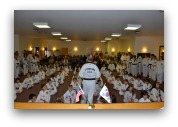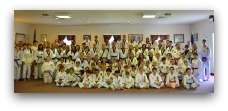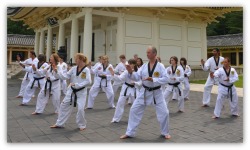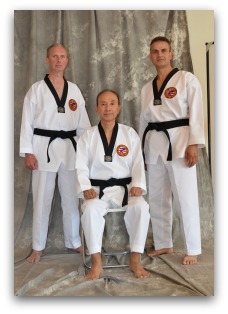by Master Doug Cook
Taekwondo Times "Traditions" Column March, 2015
The practice of
traditional taekwondo requires the student to become proficient in a multitude
of blocks, kicks, strikes and sweeps. However, in order to amplify these
techniques far beyond the limitations of the physical body, one must introduce
an element not easily definable in common terms. This element is referred to as
Ki in Korean and Chi or Qi in Chinese. Grandmaster
Richard Chun, a true pioneer and practitioner of traditional taekwondo states
that, “Ki is the cosmic ocean in which everything exists.” Ki development is an essential component of
martial arts training that is often overlooked in all likelihood due to the
metaphysical issues it raises. Nevertheless, teaching traditional taekwondo
without offering the practitioner exercises in Ki development is tantamount to
sitting someone behind the steering wheel of a car, but telling them nothing of
the fuel that powers its engine. Ki is the elixir that amplifies technique and
triggers great strength; it is the force that shields the body from harm while
maintaining health and a sense of well being when in balance.
 |
| Master Cook teaching Ki development exercises |
For centuries, since the
publication of the Nei Jing Su Wen,
or the Classic on Internal Medicine,
by the Yellow Emperor, Huang Di (2697-2597 B.C.), Asian culture and traditional
Chinese medicine in particular has recognized the existence of a force within
the human body essential to the maintenance of life.
Today, the relevance of
Ki is appreciated by millions of people who practice the discipline of taijiquan, benefit from the flowing
postures unique to qigong, and find
relief from pain through the treatment of acupuncture.
Each of these therapeutic arts in their own way relies on some form of Ki
manipulation. Besides the martial arts, use of Ki is common to other
disciplines unique to Asian culture: calligraphy, the tea ceremony, and the arrangement
of flowers, call on some form of ki management in order to advance their
practice. Still, the structure of this vital life force remains a mystery in no
small part due to its evanescent nature. Studies have been conducted in an
attempt to confirm the reality of Ki but at present, even though energy fields
surrounding the body have been measured, no concrete clinical evidence is
available to support its existence.
Physically, Ki can be
thought of as a bioelectric current. Subsequently, the martial artist can use
this energy to short circuit another’s malevolent energy causing it to betray
him in the process. One basis for this assumption is that everything in nature
is composed of matter vibrating at different energy levels; molecules are
composed of atoms bound together by electrons orbiting a minute nucleus, all
with negative and positive charges. If the practitioner can cause his
adversary’s kinetic energy to flicker, even for a moment through the use of Ki
manipulation, then he has gained the upper hand even before a blow has been
dealt. Again, while this effect, defined as combat
Ki, is unsubstantiated by science, it stands as the cornerstone of many
classical martial disciplines such as hapkido
and aikido that rely on yielding to an opponent’s negative
intentions.
To understand Ki and its
movement through the body, it is helpful to visualize systems in nature that we
are familiar with. In doing so, both the human circulatory system and an
ordinary electrical circuit come to mind. Both require a physical pathway for
transportation. Arteries, veins and capillaries carry blood. Copper wire
transports electricity. What, then, conveys Ki? Ki is thought to travel through
a series of channels or meridians
that span the body. The two grand meridians,
located on the front and back of the torso, feed a complimentary series of
channels. These pathways known as the twelve regular meridians are associated with specific organs of the body
as follows: lung, large intestine, stomach, spleen, heart, small intestine,
bladder, kidney, pericardium, triple warmer, gall bladder, and liver. An
additional eight, grouped in pairs, are known as the extraordinary meridians and perform a separate function.
Nevertheless, all of
these meridians are invisible to the eye resulting in great skepticism
concerning their existence. However, it is these very meridians and their
related pressure points that the acupuncturist stimulates for therapeutic
purposes and the martial artist activates to amplify technique. By removing blockages
in the meridial system, which can cause illness and in extreme cases, death,
the practitioner of traditional Chinese medicine has the power to cure a
variety of diseases. Conversely, the taekwondoist, by striking one or more of
the many acupoints that dot the body, can incapacitate an attacker.
Metaphorically speaking, these pressure points are similar to stations along a
railway. Yet, rather then bearing the name of a town or village, they are
designated by a number and the anatomical organ with which they are associated.
The meridians mirror the tracks while Ki itself would be the engine traveling
along the rails. This analogy, while simplistic at best, crudely describes the
method of how Ki is distributed throughout the body.
Located two inches below
the navel, the Ki center (tanjun in
Korean, or dantien in Chinese),
represents the reservoir from which Ki radiates. In Chinese, dan is defined as crystal or the essence
of energy, while tien is translated
as the area for the essence of energy. It is here that Ki is stored after
entering the body. According to Reed, the tanjun is best described as the
“one-point, a tiny star, or vortex sucking in immense amounts of energy from
the universe.”
There are many theories
regarding the tanjun, the foremost being that it is the physical, cellular
center of the human anatomy from which the body develops outward from
conception. It is also considered ones natural center of gravity around which
the extremities move. This concept becomes all the more evident when we view
the contrasting outlooks between Eastern and Western culture in regards to the
hub of human intent. In Western society, we often say that we “think from the
heart”; heart ache, heart break, and heart-felt thanks are all conceptual
indicators of this principle. Conversely, in Eastern thought, intention is said
to emanate from the hara in Japanese,
or, as we now know in Korean, the tanjun. This fundamental difference in belief
reflects the conviction that the vital life force is distributed from the body’s
center and, thus, can be stored, channeled, manipulated, and amplified to
promote health and intensify technique in the case of the martial artist.
Hence, it can be said that Ki not only projects, but protects.
Yet, before one can knowingly utilize Ki to
their advantage, they must first acknowledge and trust in its existence. This
requires a leap of faith for many Westerners. Ki is benevolent in nature and,
therefore refuses to be abused. Through it, the martial artist can dominate,
but not terrorize. If the practitioner of qigong, acupuncture, or the martial
arts attempts to
manipulate Ki for selfish or malevolent purposes other than
cultural tradition, therapeutic value, or self-defense, it is sure to fail them
every time. Called upon properly, however, with respect, dignity, and benign
intent, it will focus intention, heal, nurture a sense of well being, and
amplify traditional taekwondo technique far beyond the limitations of the
physical self.
 |
| Master Doug Cook |
Master Doug Cook, 6th dan black
belt, is head instructor of the Chosun Taekwondo Academy located in Warwick,
New York, a senior student of Grandmaster Richard Chun, and author of four
best-selling books focusing on taekwondo. He has been a TaeKwonDo Times
columnist over fifteen years. Master Cook can be reached for seminars, training
tours to Korea, workshops or questions at www.chosuntkd.com
or info@chosuntkd.com.







 Kamsahamnida to all tour participants, family members, friends and fellow students at home who followed us online! It is not too early to consider making a dream come true in two years by reserving your place on the
Kamsahamnida to all tour participants, family members, friends and fellow students at home who followed us online! It is not too early to consider making a dream come true in two years by reserving your place on the 
